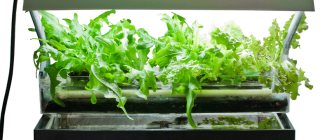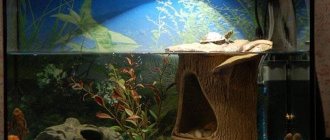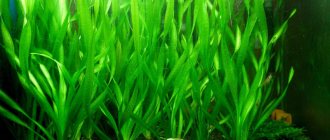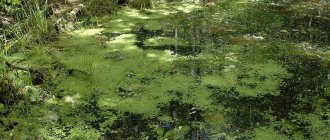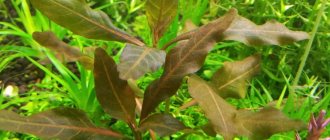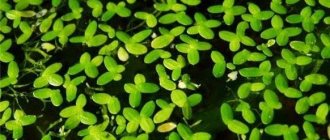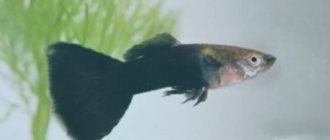Vegetation preparation
Before planting a plant, it is given a visual assessment. The damaged or weak part is carefully removed. The root system is cleared of soil lumps. If necessary, the roots are washed under running water.
The powerful root system is cut through and trimmed. Leave 2–4 cm. This procedure is carried out so that the selected vegetation takes root and the root system develops better. Excessively thin roots are not touched, since their integrity is easily damaged.
Representatives of the flora, which have a long stem, are often not replanted because they do not take root well.
Before planting plants in the aquarium, they are disinfected. To do this, prepare a solution that includes table salt. With the help of this composition, pathogenic microorganisms and infections are removed.
Installation of decorative elements
Initially, the selected substrate is poured into the new tank and decorative elements are installed. If necessary, grottoes, driftwood and other components are decorated with selected vegetation. The procedure is carried out before water is poured into the aquarium. After all, the scenery often moves during the process.
Java moss and some types of ferns are used to decorate driftwood, smooth and flat stones. To fix them, a nylon thread is used. Within 10–14 days the thread will collapse. This time is enough for the moss to attach to the stone or driftwood.
Pouring water into the container is performed in several stages. Each time the level is raised by 1–2 cm.
Disembarkation rules
Aquarium plants are planted in two ways:
- Planting is carried out in a substrate laid at the bottom of the tank. Filling with water is carried out after some time. This option is advantageous in that the root system penetrates deeper into the soil and is more firmly anchored.
- The plant is planted in a container filled with water. This method is used when planting those species that have long stems.
Landing rules
In order for the planted aquarium plants to take root and delight the owner with luxurious branches and bright colors, the flora should be planted correctly. There are two options for planting plants in an aquarium:
- The vegetation is placed in the soil located at the bottom of the tank, and the tank is filled with water after a certain time. This method allows for a stronger fixation of greenery in the soil.
- Flowers are planted in a tank immediately filled with liquid. This method is used for growing flowers with a long stem.
How to properly place plants in an aquarium
In order to grow beautiful green thickets in an aquarium, the types of flora should be placed correctly. Aquarium vegetation is divided into several categories, each of which has its own place on the territory of the reservoir:
- foreground greenery;
- middle and background;
- solitaire flowers;
- vegetation in pots.
The design of the tank begins with planting flora on driftwood or large stones. If the owner has such a desire. This process is carried out in a container without water, securing mosses and ferns using nylon thread or fishing line. After the flora is fixed, you need to pour a little liquid into the container.
Aquarium plants in the foreground are planted using tweezers, while the roots are lightly pressed with soil. The process will take a lot of time and effort, so you should be prepared in advance. The following types of greenery will look good in the foreground of the aquarium:
- small varieties of Echinodorus that will cover the bottom with a green carpet;
- cryptocorynes, unpretentious to the conditions of detention;
- dwarf anubias, however, this species is quite picky about lighting.
After planting flowers in the foreground, it is necessary to arrange the vegetation in the middle and background, observing the following rules:
- Stem flora is placed in groups, with taller ones planted in the back and lower ones in the front;
- types of greenery that are identical in color and type are not placed next to each other;
- when filling the middle and background of the tank, you should select different types of flora and combine flowers;
- An important rule for proper design is that each type of flora or decorative element should be visible at least a little.
Having finished decorating the space, you can place solitaire flowers, if the size of the tank allows it. As tapeworms, two or three large flowers are usually chosen, which are planted separately from each other at a great distance. Nymphs, crinums or large echinodorus are ideal for these purposes.
It should be borne in mind that it is impossible to use tapeworms in small tanks, as they will disrupt the harmony of the composition.
When choosing types of flora for an aquarium, the owner may like capricious or exotic varieties of flowers that require an individual type of soil to grow and develop. In this case, you can find a way out of an insoluble situation by using ordinary pots for planting. In order not to spoil the appearance of the reservoir, experienced owners use colorless containers that can be moved around the tank and, if necessary, disguise the container, giving the aquarium a natural look.
If it is not possible to use pots for planting, then the bottom area is delimited into several sections by partitions made of glass or plastic. The required type of soil is placed in the resulting empty areas, and the plants you like are quietly placed.
Planting plants in an aquarium is an important part of decorating a pond, which helps maintain biological balance in the tank. In order for the flowers to grow and delight the owner with a lush and healthy appearance, the greens must be properly planted in the ground and care for the flora, pruning lush bushes and removing dead parts.
Foreground decoration
Experienced aquarists begin filling the tank from the front. After all, planting plants near the front wall is difficult, since the number of suitable species is limited.
For these purposes, dwarf-type Anubias are used. But they require regular lighting. Therefore, only experienced aquarists can grow them. For planting, tweezers are used to press the root system.
Plants - tapeworms
Solitaire plants – due to their bright colors or unusual shapes, they captivate the eye . Use no more than 2–4 tapeworms, planted in separate bushes in different parts of the aquarium. Echinodorus (heart-leaved, Uruguayan, Blechera, “Ruby”) will look wonderful, striking with their variety of shades and sizes, as well as the huge size of the delightful nymphaeum water lilies.
Lotus water lilies of various colors will add splendor to the design. An absolutely unpretentious plant that takes root well even in soil poor in microelements. Planted both in the center and closer to the foreground.
An unusual plant is crinum wavy, for successful care it requires well-fertilized soil with a layer of at least 7 cm or a nutrient substrate. Especially in large aquariums (over 500 liters), floating crinum is very effective.
Reference! If you decide to decorate the underwater world with wonderful echinodorus, you need to take into account their rapid growth.
They need frequent pruning of side stems that shade the plants underneath them. Therefore, they should be protected from proximity to light-loving plants.
Aquariums up to 100 liters should not be filled with large-leaved and tall tapeworms; they will not leave space for the development of other vegetation. Opt for compact types.
A very easy to maintain plant, suitable for small aquariums Aponogeton curly . For aquariums up to 60 liters, you can choose a replacement for tapeworms among smaller specimens of the unpretentious Echinodorus parviflora. A wonderful decoration would be Barclaya longifolia in red color, a beautiful capricious plant that loves a lot of light.
Containers for florariums
The first requirement is transparency. Any waterproof, rigid material with good light transmission will do: glass, plexiglass, extruded polystyrene foam. There are also models made of wood with transparent inserts. The choice of shape and type of container depends on the type and size of plants, the location of the florarium and the creative idea.
The simplest and most elegant solution for homemade open florariums is special vases for succulents. They can be round, cylindrical, cubic or trapezoidal. Vases are sold with and without lids.
Designer vases of unusual shapes
Their walls are half or even less lower than ordinary vases. Due to this, the container is maximally open to air and light. Such conditions are optimal for dry florariums, where succulents and cacti thrive.
Low-sided bowls are ideal for plants in arid climates
Aquarium
The fish house comes with useful accessories: an internal filter, a lamp, an air compressor, a heater and a sprayer. They simplify the maintenance of the mini-greenhouse. If you plan to use the aquarium after fish or other living creatures, it is important to thoroughly clean and disinfect it before starting.
In containers
For particularly demanding plants that need special soil, pots are used. Clay containers are preferable, but plastic containers can also be used.
Holes are made at the bottom of the pot for ventilation. The pots are lowered to the bottom and sprinkled with soil for camouflage. It is important to choose the correct size of container in relation to the tank. Too large pots will cause disruption of the ecosystem and the death of fauna.
Some species of underwater inhabitants like to swarm in the sand, which can harm the roots of vegetation. If the root system is poorly developed, then such vegetation is also placed in special containers.
Important! The adaptation period of the planted species takes 2–4 weeks. If after this period the root system of the plants does not develop, then you should pay attention to the composition of the aquarium water and use fertilizers.
When creating underwater tropics, it is important not to overdo it. Before landscaping, it is necessary to clearly delimit the green zone; it should not exceed 1/3 of the total area.
The balance of flora and fauna in an aquarium is necessary for the comfortable existence of all living organisms . It is very important to observe the light regime of the day; timers will help with this. Oxygen saturation of the aquatic environment due to plants occurs in daylight; at night they absorb it. This can lead to oxygen starvation in fish and their death.
Recommendations
When filling aquarium spaces, the following rules are observed:
- To plant algae, use those areas of the tank that receive the maximum amount of light. After all, they develop well in intense light.
- Large-leafed and tall plants are planted in the corners of containers, along the back wall. Their shadow will not fall on other vegetation. If necessary, the stems of some species are trimmed. This is done in accordance with the recommendations of specialists.
- Many representatives of the fauna swarm in the substrate. Therefore, the integrity of the root located in the soil may be compromised. If the root system is poorly developed, then such vegetation is placed in pots and special containers.
- The adaptation period of the planted species takes 2–4 weeks. If after this period the plant root system does not develop, then the aquarium water parameters are adjusted and nutrients are introduced. Excessively weak species are removed from the tank.
- When placing aerators or pumps in a container, it is necessary to ensure that they do not violate the integrity of the root system and stems.
- Periodically, the substrate is siphoned. This is done to eliminate organic matter, nitrates and harmful components that settle on the decorations and soil.
Decorating aquariums with plants is done with special care. Experienced aquarists plant groups of one or two species at a time. If such actions are not taken, the likelihood of an algae outbreak increases significantly. After all, small groups of plants cannot cope with the growth and spread of red or blue-green algae.
ARTIFICIAL PLANTS FOR AQUARIUM - HOW TO PREPARE THEM SO THAT THEY LOOK LIKE REAL?
PLANTS FLOATING IN THE AQUARIUM. WHICH IS BETTER TO CHOOSE?
WHICH MOSS TO CHOOSE FOR AN AQUARIUM? TYPES OF AQUARIUM MOSSES
Diseases and care
Why don't plants grow in an aquarium?
If you notice a slowdown in the growth of aquatic plants, you will need to check the water hardness and introduce fish that are careful about the landscape. Some types of plants take a long time to get used to a new place. Try cleaning the soil and partially replacing the water. And most importantly, reconsider the temperature.
Why does plaque appear?
The cause of black plaque is an infestation of harmful algae. To get rid of this problem, it is necessary to regularly change the water and remove all unwanted impurities from the soil. Black beard is treated with a product called JBL Algol. It may also be necessary to update the entire aquarium, replace some of its inhabitants and feeding regime.
Why do plants rot and turn black?
Blackening and rot on the roots are a consequence of problems with the soil. There may be organic deposits buried deep in the soil. Excessive soil density may also be a problem; loosening is required. Soil acidification is also undesirable.
Rotting and depletion of stems occurs with poor lighting. It is worth reviewing the light supply schedule.
Sometimes cryptocoryne and some other plant species become infected with rot. This disease is provoked by oversaturation with nitrates, sudden cooling or changes in the properties of water. For treatment, you do not need to touch the plant, just set the correct environmental parameters and change the water frequently.
How to disinfect aquarium plants?
Plants are disinfected according to the instructions given by the manufacturer. They are kept in a disinfectant liquid for some time. Only experienced aquarists can do everything right. Here are the suitable drugs:
- bicillin;
- white solution;
- buprofezin;
- methylene blue;
- imidacloprid;
- alum solution;
- trichlorphan;
- peroxide solution;
- ammonia solution;
- sodium permanganate solution.
